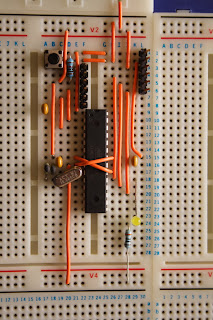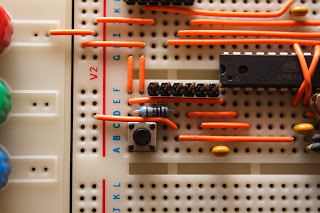 Received a couple of nice big bread boards for Christmas and decided that one of them needed an arduino to use with it. After some thought I decided that the best option was to build the required parts of an Arduino circuit direct on the breadboard. Also the cheapest at only £4 for the required parts.
Received a couple of nice big bread boards for Christmas and decided that one of them needed an arduino to use with it. After some thought I decided that the best option was to build the required parts of an Arduino circuit direct on the breadboard. Also the cheapest at only £4 for the required parts.The required sections of the circuit for general Arduino development are:
ATMega micro-controller, in this case an ATMega328 with 100nF capacitor across ground and VCC near chip
Oscillator - 16MHz crystal and 2x 22pF capacitors
Reset - push to make button and 10KOhm resistor
Serial programming - 6 pin header, reset decoupling capacitor 100nF
Optional sections are:
Pin13 LED - LED and suitable resistor
ARef smoothing - 100nF capacitor
ISP - 6Pin header to allow connection to an In System Programmer
If you don't have the use of an in system programmer for the ATMega devices then the ATMega328 needs to be purchased with the Arduino bootloader already flashed to it. There is little difference in cost. I used the Duemilanove bootloader.
Also required is FTDI USB to TTL serial adaptor. I prefer the Sparkfun "FTDI Basic" board because breaks out DTR rather than RTS as in many converters. This means that the Arduino IDE can reset the Arduino itself when uploading programs. A USB to Serial converter which provides RTS can be used but you have to manually reset the Arduino circuit during the programming cycle.

The circuit I used is provided here in picture on the right. Also I as was using Fritzing an image of the a bread board layout is provide.

The photos below shows a close up of the serial programing connection and on the right some of the wiring is removed to show hidden links.


That is a very interesing project. how you did the coding.
ReplyDeletewhat is arduino